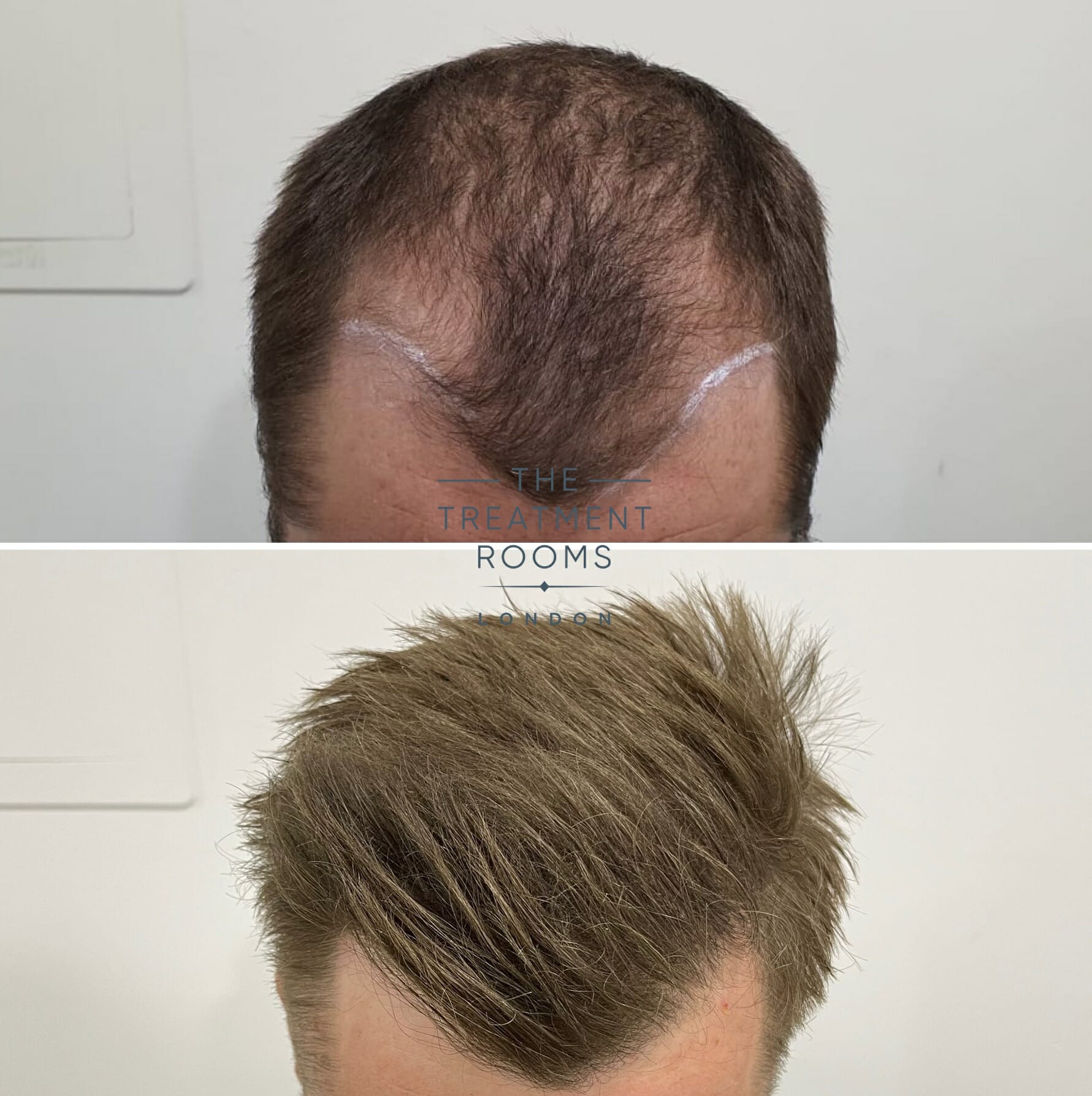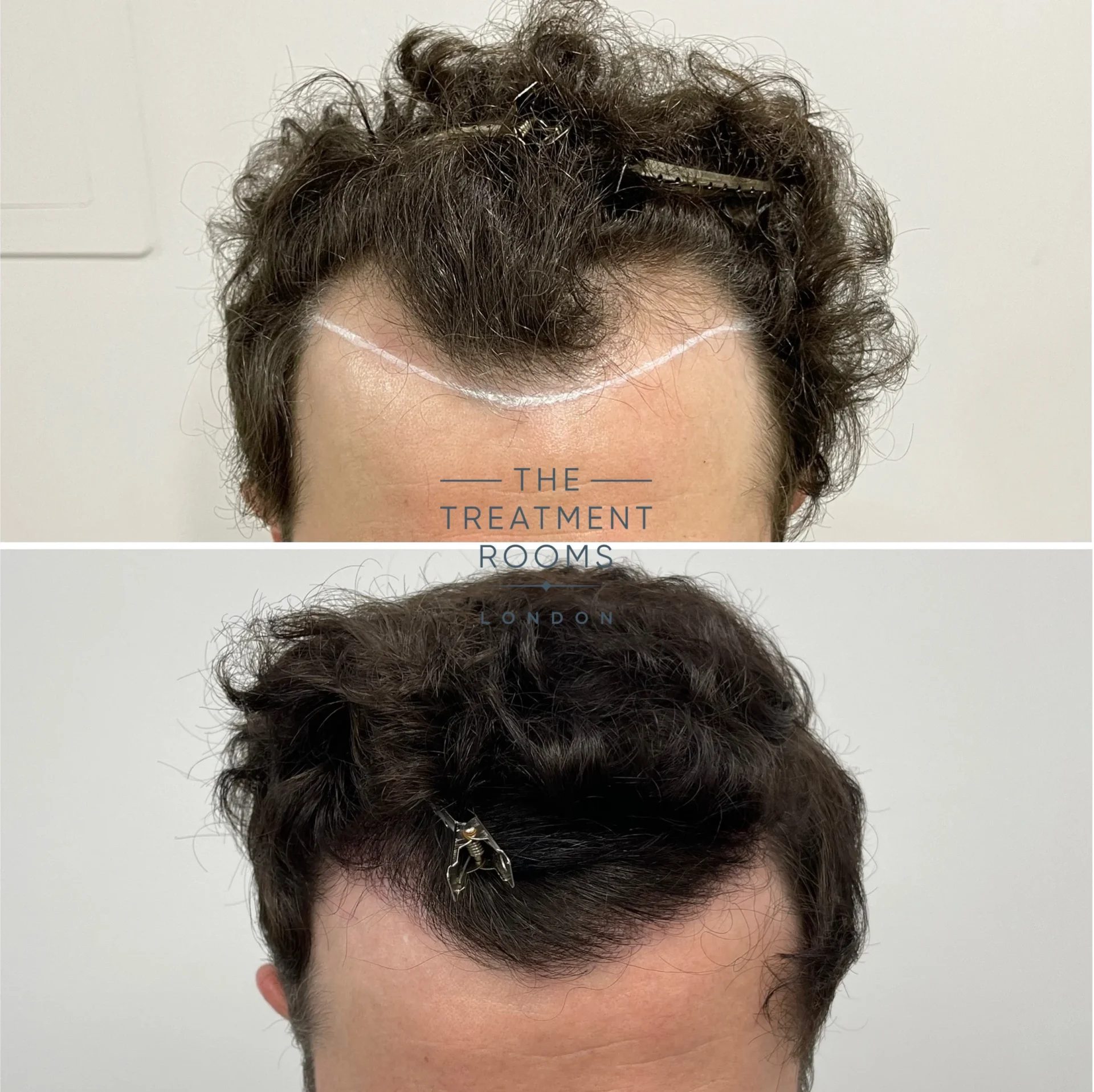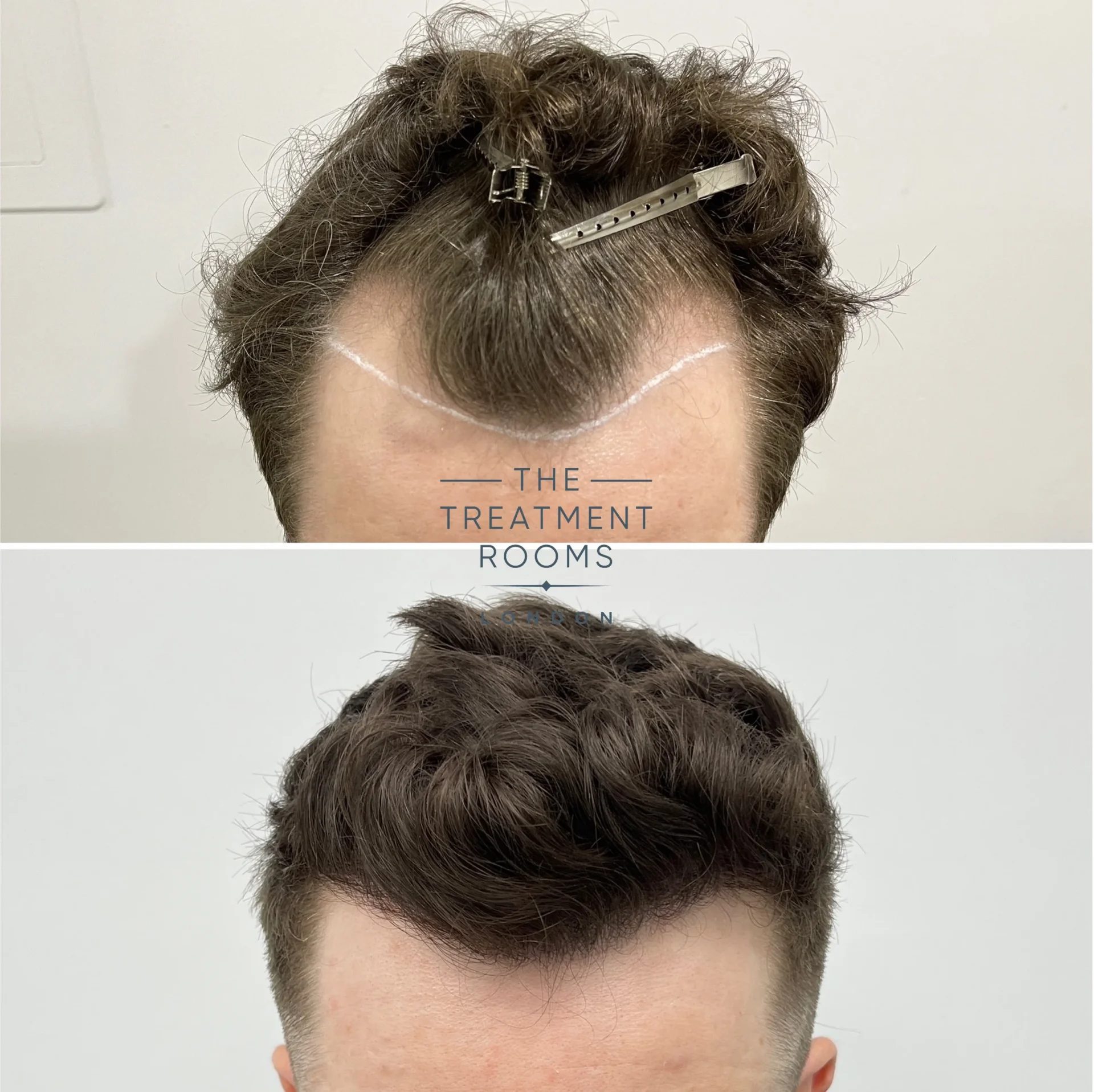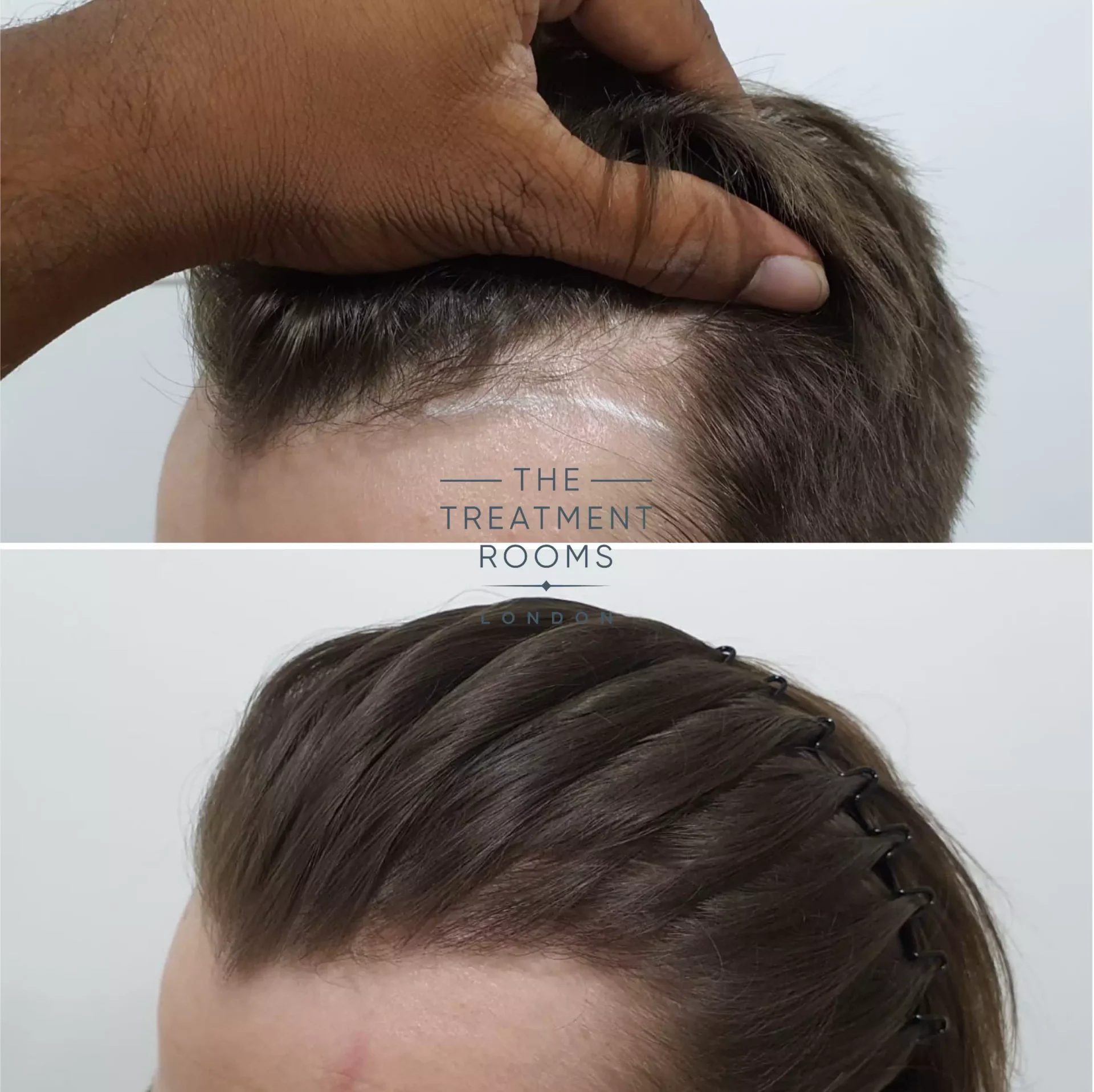Temple hair loss is characterised by hair thinning and either side of the hairline creating an "M" or "V" shaped hairline. Temple hair loss can be surgically treated by by undergoing a hair transplant to the areas either side of the "M" or "V". A temple hair transplant involves relocating hair from the back and sides of the scalp into the temples. The transplanted hair takes 9-12 months to grow and will last 10-20 years.
The Surgeons at The Treatment Rooms London are world renowned experts in performing temple hair transplants using the unshaven technique giving patients a quicker recovery time.
In this blog, we are going to be exploring temple hair loss, from what the condition is, to symptoms, causes, and temple hair loss treatment options; including medication and temple hair transplants.
What is temple hair loss?
It is estimated that male pattern baldness (androgenic alopecia) – one of the most common types of hair loss – affects more than half of men over 50 in the UK. Temple hair loss is a common form of male pattern baldness. It occurs in the temples, between the forehead and the ears, behind the eyes. It can contribute to a V-shaped hairline that is common in men and it can be called a widow's peak. It is a common area that is transplanted in patients.
At The Treatment Rooms London we recommend patients explore treatment for their temples with:
1. Hair transplant surgery to restore hair in the temples to its natural direction and angulation
2. Hair loss prevention medications such as Finasteride and Minoxidil to stop the temple hair loss getting worse and involving the entire hairline
Tyler’s Temple Hair transplant
Type of Surgery : FUE hair transplant
Hair Loss Level : Norwood 3
Number of Grafts : 1243
"I was recommended The Treatment Rooms and after seeing their results"
Temple hair transplant surgery
The main technique used for a temple hair transplant is the FUE hair transplant technique. The process involves the extraction of hair from the ‘donor area’ and transplanting this hair to the temples to provide thicker hair. The process of temple hair transplant surgery can help:
- Restore good density in the temples that blends with the forelock and mid-scalp
- Recreate a cowlick if you had one previously in your temples
- Recreate natural hair direction and angulation so the new hair transplant looks no different to your hair previously
After a hair transplant you will be able to style and groom your hair as normal. Your temple hair transplant should last 10-20 years or longer.

Temple hair transplant cost
The cost for temple hair transplant surgery will be based on the size of your temples. Typically the price for FUE hair transplant surgery in the temples ranges between £5,000- £6,000.
The cost will be dependent on the number of grafts you require for surgery, your hair type and whether you wanted to opt for a minimally shaven or unshaven temples hair transplant. It is quite common for patients to undergo a minimally shaven transplant for the temples region as it quickens their recovery time and return to work.

Why is my hair receding at the temples?
There is a range of different factors that can contribute to hair loss at the temples. Male pattern baldness (androgenic alopecia) is one of the most common types of hair loss. It is a genetic condition that often involves temple hair loss in its early stages. Female pattern baldness – characterised by a loss of hair density - does not typically begin at the temples in the same way that male pattern baldness does.
Other potential causes of temple hair loss are:
- Stress
- Traction alopecia (caused by ‘tight’ hairstyles like cornrows and ponytails) pulling and damaging the hair on the temples
- The side effects of some medications like Epilim or Sodium Valproate

Temple hair transplant surgery carried out by our Hair Transplant Surgeons
Preventative treatment for temple hair loss
There are several ways to help prevent temple hair loss, and the most suitable course of action will vary according to the cause of the hair loss. Let’s look at some of the ways that you can help to prevent temple hair loss:
- Avoid damaging hairstyles – There are a number of hairstyles and hair treatments that could be a factor, including; tight hairstyles that cause traction alopecia such as cornrows, ponytails, buns and braiding; using hair dye; using hot styling tools like rollers, straighteners and blow dryers; and chemical texturizers
- Treat health conditions that cause hair loss – By taking prescribed medication for underlying health conditions – such as systemic lupus erythematosus, thyroid disorder, syphilis, or a hormonal imbalance – that can cause hair loss, you should see your hair start to thicken.
- Focus on a healthy diet – Pack your daily food intake with vitamins, minerals and omega-3’s, and try to cut out refined sugars and processed foods
- Support your hair growth with supplements – Hair growth supplements can augment your diet by supplying you with nutrients that are conducive to hair growth. They usually come in tablet or capsule form
- Use hair regrowth products – Try hair regrowth products such as formulas that contain minoxidil. These products help to prevent hair loss and promote hair growth
- Relieve your stress – Stress causes hair loss, and so if you have a method of relieving it; all the better in the battle against temple hair loss. Exercise regularly and get enough sleep. There are also many other potential ‘stress busters’; from massage to meditation, aromatherapy and acupuncture
In addition to these methods of helping to prevent temple hair loss, there are several treatments available; such as non-invasive and surgical procedures.

Hair transplant for hair loss in the temples
Non-surgical hair loss treatment for temple hair loss
There is a range of non-surgical techniques available that can help combat the signs of temple hair loss without having to undergo a hair transplant. Non-surgical hair loss treatments such as:
Finasteride treatment
The cause of male pattern baldness is understood to be the conversion of testosterone into DHT, which then affects and thins hair follicles, making your hair fall out. Finasteride prevents this process from happening by halting the conversion of testosterone to DHT which prevents further hair loss. However, it’s only advised in the use of preventing further hair loss, it cannot necessarily regrow hair where it has been lost.
Minoxidil treatment
Typically coming in a topical solution, hair regrowth products containing minoxidil, such as Regaine, can make a visible difference with consistent use. The medication is applied directly onto the scalp to help prevent hair loss and thicken existing hair. Unlike Finasteride, Minoxidil can also treat hair loss in women, not just in men.
These treatments are advised to be explored before opting for a hair transplant as they may prove to be the perfect solution for your temple hair loss. However, you should always consult your doctor before using these products.
View and hear our patients talk about their temple hair transplant and the treatments available to them in the video below.
How we can help restore your temple hair loss
We offer a range of hair loss treatments that provide excellent results, giving our patients a more youthful, confident look. Whether you desire a hair transplant, or a non-invasive hair loss treatment, our experienced surgeons will be with you every step of the way, from the initial consultation right through to the aftercare and recovery process.
As a CQC registered clinic, we follow stringent health and safety guidelines and only employ fully-qualified surgeons that are regulated by the GMC, which means you’re in good hands. So if you want to restore the hair loss around your temples, book a consultation with The Treatment Rooms London today.
Authored by
Reviewed by
FUE HAIR TRANSPLANT REVIEWS
Latest News
Analysing Jurgen Klopp’s Hair Transplant
December 23, 2020
As the manager of one of the world’s most successful football clubs, Liverpool FC, Jurgen Klopp is…
Does Wearing A Hat Cause Baldness?
November 25, 2020
Hair loss can be caused by many different factors. Some instances of male hair loss are simply…
Is A Hair Transplant Safe?
November 18, 2020
‘A hair transplant is generally a safe procedure’, notes the NHS. Why, then, is the safety of…
Book A Consultation





















